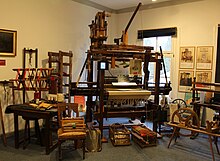Lennep Cloth Museum
The Tuchmuseum Lennep in Remscheid district Lennep documents the history of the textile industry in the Bergisch Land . It is located at Hardtstraße 2 in the GGS Freiherr vom Stein building. Opposite (entrance Schwelmer Straße) is the Röntgen Museum .
Subjects of the museum
The museum management presents the following topics in the six rooms:
- Room 1: Trading houses - bridges to new markets that market the Bergisch cloth.
- Room 2: Cloth making, pioneers of industrialization. From hand-spun thread to a woven piece of cloth. The process of production of carded yarn, worsted yarn and weaving.
- Room 3: The Wupper - the cradle of the Lennep cloth industry. Growing industry on the banks of the Wupper. The river provides energy, water and moisture. Electricity plants arise.
- Room 4: Lennep, the city of drapers . Privileges, certificates and contemporary documents from a 750 year old town in the Bergisches Land.
- Room 5: Private Initiative: Corporate Social Responsibility. Workers' houses, the colony in Lennep, social institutions as foundations Lennep entrepreneurs.
- Room 6: Lenneper Cloth Industry. Fashion and colors in 100 years. The design engineers supplied thousands of samples for two collections per year .
Presentation of the history of Bergische Textilfabrikation
While in the Wülfing Museum in Dahlerau by the association "Johann Wülfing & Sohn - Museum e.V." a preserved industrial monument of a textile factory with a functional machine park is presented, the history of the Bergische textile industry is documented in Lennep by the Anna Hardt Foundation in a school building using the example of the Johann Wülfing & Sohn company . The last Bergische cloth factory closed in 1996. After 10 years of textile museum in Wülfing, the cloth museum continued its work in Lennep. Both museums complement each other in their representations.
The Anna Hardt Foundation from 1838 was originally a family foundation with a social statute. It was not until 1989 that the Hardt family gave the foundation new statutes with a cultural task, namely research into cloth making in the Bergisches Land using the example of Johann Wülfing & Sohn and other companies such as Peter Schürmann & Schröder in Vogelsmühle , Hardt Pocorny & Co. in Dahlhausen and Hardt & Co. New York and Berlin . An extensive company and family archive is made available to the public at the Rheinisch Westfälisches Wirtschaftsarchiv zu Köln , RWWA, holdings 122. It has already served as the basis for many scientific papers. A comprehensive finding aid was created by the RWWA and can also be viewed online.
history
In 1984 the then management of the Johann Wülfing & Sohn company under Hans Frank decided to set up a factory museum together with the company's last personally liable partner, Detmar Hardt. There have already been a number of examples in German industry. The old mansion on the company premises should be prepared for this, as it would otherwise not be used for business purposes. The preparations should run without major financial outlay, as the situation of the last textile company on the right bank of the Rhine was difficult. The management had the approval of the workforce.
Franz Werner von Wismar, who had been in charge of the group's archives since 1976, was brought in to set up the factory museum. The project dragged on for three years, but only cost the company around 100,000 DM, which was mainly used for the renovation of the company building.
The museum was inaugurated in 1987. The company's employees were invited as the first visitors. Word quickly got around about the existence of the factory museum and groups of visitors traveled by bus and had the opportunity to see the factory and museum. Many of the visitors took advantage of the company's retail outlet and bought jackets, trousers and suits. For his cultural commitment, the landscape assembly chaired by Jürgen Wilhelm, the then President, awarded Detmar Hardt the Rhineland thaler. For ten years, until 1997, the factory museum was open to visitors until the factory closed.
After all the exhibits had been packed, the search for a new domicile turned out to be difficult. Finally, the premises in the GGS Frhr. v. Stone found. After the politics and administration of the city of Remscheid had found a feasible way, the renovation work began. The permanent exhibition was able to move into the newly designed rooms within a short time.
In the summer of 1997 the cloth museum was opened to the public in the presence of the municipal representatives for Remscheid and Radevormwald . Since then, the museum has been run by volunteers. The sponsor is the Anna Hardt Foundation eV based in Remscheid.
Web links
Coordinates: 51 ° 11 ′ 36.6 ″ N , 7 ° 15 ′ 37.6 ″ E

